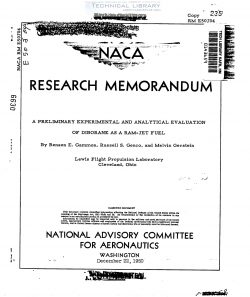naca-rm-e50j04
- Version
- 26 Downloads
- 1.33 MB File Size
- 1 File Count
- April 24, 2017 Create Date
- April 24, 2017 Last Updated
National Advisory Committee for Aeronautics, Research Memorandum - A Preliminary Experimental and Analytical Evaluation of Diborane as a Ram-Jet Fuel

A preliminary analytical and experimental evaluation of diborane
as a ramrjet fuel has been made because there is a need for a ramrjet
fuel that will permit a realization of flight range, thrust, and com-
bustion stability beyond those'attainable with petroleum fuels.
Diborane, though at present expensive and not readily available, is a
fuel that appears to offer some of these needed characteristics.
Air specific thrusts of 80 percent of the ideal values were ,
attained for diborane. The experimental air specific thrusts for '-
diborane were approximately equal to the ideal values for octane-l for
corresponding values of the stoichiometric fraction of fuel. With
diborane, smooth stable operation of the combustor unit was maintained
over a range of fuel-air ratios from 0.0015 to 0.10 and at combustor
inlet-air velocities up to 500 feet per second in the absence of a
flameholder. Stable combustion of hydrocarbon fuels was not attained
in a combustor employing the identical configuration as that used for
diborane. This stability and range of operation is apparently related
to the wide inflammability limits and to the extremely high spatial
flame speeds of diborane-air mixtures. Spatial flame speeds for
diborane—air mixtures as high as 169.5 feet per second were observed
under conditions where normal hexane gave a spatial flame speed of
5.22 feet per second or less.
Flight range calculations for an altitude of 20,000 feet, flight
Mach number of 1.665, and ambient temperature of 562° R, indicate that
liquid diborane is capable of maximum ranges as much as 50 to 50 percent
greater than that obtained with aviation gasoline, depending.upon the
weight of equipment necessary to maintain the diborane as a liquid during
flight. If diborane is carried as a gas, it is inferior to aviation
gasoline from the viewpoint of the available range.
| File | Action |
|---|---|
| naca-rm-e50j04 A Preliminary Experimental and Analytical Evaluation of Diborane as a Ram-Jet Fuel.pdf | Download |

Comment On This Post